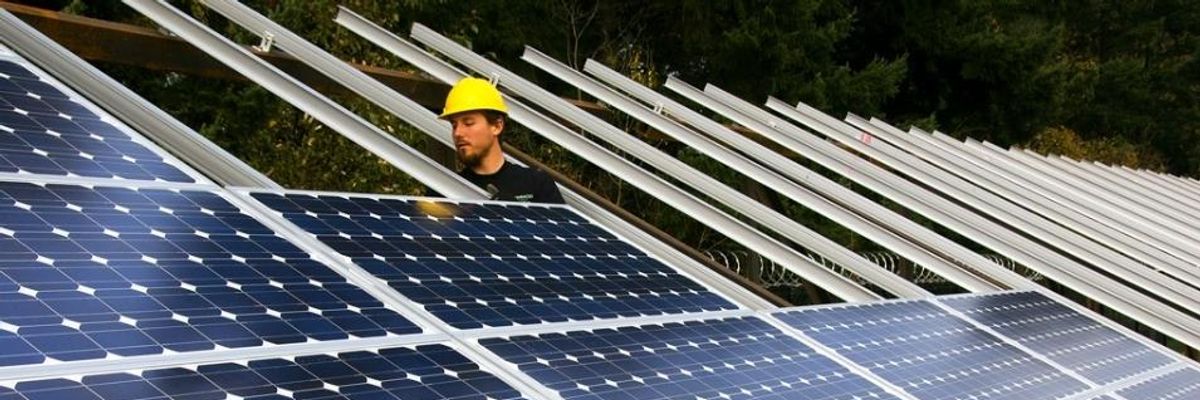
"In the industrialized world, Denmark will be the vanguard of renewable energy by 2022, with 70 percent of its electricity generated by wind, solar and other renewables," Cole writes. (Photo: Oregon Department of Transportation/Flickr/cc)
To donate by check, phone, or other method, see our More Ways to Give page.

"In the industrialized world, Denmark will be the vanguard of renewable energy by 2022, with 70 percent of its electricity generated by wind, solar and other renewables," Cole writes. (Photo: Oregon Department of Transportation/Flickr/cc)
A new International Energy Agency report contains some startling findings about solar energy dominance and its future.
1. Renewables comprised 66% of all new net electricity capacity additions in 2016. Two-thirds of added capacity, in other words, consisted of photovoltaic solar cells, wind turbines and biofuels.
2. 165 gigawatts of new solar was added in 2016.
3. In 2016, new solar photovoltaic capacity globally grew by 50 percent.
4. China accounted for half of this additional solar capacity and for 42% of all new renewables additions.
5. Solar additions grew faster than any other fuel, leaving coal in the dust.
6. By 2022, the IEA expects nearly 1000 gigawatts of new solar to have been added internationally, an increase of 42 percent over today, in just 5 years.
7. Developments in India are also startling. By 2022 that country is expected to double its renewables electricity generation capacity (mainly wind and solar), a lightning fast pace of growth that is higher than the forecast for Europe.
8. Indian energy auctions yielded remarkably low prices for both wind and solar projects. In some Indian states, recent bids have been among the world's lowest, and in some cases so low as to complete successfully with coal.
9. In the industrialized world, Denmark will be the vanguard of renewable energy by 2022, with 70% of its electricity generated by wind, solar and other renewables.
10. In several major European states, the share of wind and solar in electricity generation will come to 25%.
Trump and Musk are on an unconstitutional rampage, aiming for virtually every corner of the federal government. These two right-wing billionaires are targeting nurses, scientists, teachers, daycare providers, judges, veterans, air traffic controllers, and nuclear safety inspectors. No one is safe. The food stamps program, Social Security, Medicare, and Medicaid are next. It’s an unprecedented disaster and a five-alarm fire, but there will be a reckoning. The people did not vote for this. The American people do not want this dystopian hellscape that hides behind claims of “efficiency.” Still, in reality, it is all a giveaway to corporate interests and the libertarian dreams of far-right oligarchs like Musk. Common Dreams is playing a vital role by reporting day and night on this orgy of corruption and greed, as well as what everyday people can do to organize and fight back. As a people-powered nonprofit news outlet, we cover issues the corporate media never will, but we can only continue with our readers’ support. |
A new International Energy Agency report contains some startling findings about solar energy dominance and its future.
1. Renewables comprised 66% of all new net electricity capacity additions in 2016. Two-thirds of added capacity, in other words, consisted of photovoltaic solar cells, wind turbines and biofuels.
2. 165 gigawatts of new solar was added in 2016.
3. In 2016, new solar photovoltaic capacity globally grew by 50 percent.
4. China accounted for half of this additional solar capacity and for 42% of all new renewables additions.
5. Solar additions grew faster than any other fuel, leaving coal in the dust.
6. By 2022, the IEA expects nearly 1000 gigawatts of new solar to have been added internationally, an increase of 42 percent over today, in just 5 years.
7. Developments in India are also startling. By 2022 that country is expected to double its renewables electricity generation capacity (mainly wind and solar), a lightning fast pace of growth that is higher than the forecast for Europe.
8. Indian energy auctions yielded remarkably low prices for both wind and solar projects. In some Indian states, recent bids have been among the world's lowest, and in some cases so low as to complete successfully with coal.
9. In the industrialized world, Denmark will be the vanguard of renewable energy by 2022, with 70% of its electricity generated by wind, solar and other renewables.
10. In several major European states, the share of wind and solar in electricity generation will come to 25%.
A new International Energy Agency report contains some startling findings about solar energy dominance and its future.
1. Renewables comprised 66% of all new net electricity capacity additions in 2016. Two-thirds of added capacity, in other words, consisted of photovoltaic solar cells, wind turbines and biofuels.
2. 165 gigawatts of new solar was added in 2016.
3. In 2016, new solar photovoltaic capacity globally grew by 50 percent.
4. China accounted for half of this additional solar capacity and for 42% of all new renewables additions.
5. Solar additions grew faster than any other fuel, leaving coal in the dust.
6. By 2022, the IEA expects nearly 1000 gigawatts of new solar to have been added internationally, an increase of 42 percent over today, in just 5 years.
7. Developments in India are also startling. By 2022 that country is expected to double its renewables electricity generation capacity (mainly wind and solar), a lightning fast pace of growth that is higher than the forecast for Europe.
8. Indian energy auctions yielded remarkably low prices for both wind and solar projects. In some Indian states, recent bids have been among the world's lowest, and in some cases so low as to complete successfully with coal.
9. In the industrialized world, Denmark will be the vanguard of renewable energy by 2022, with 70% of its electricity generated by wind, solar and other renewables.
10. In several major European states, the share of wind and solar in electricity generation will come to 25%.